About Sicily – Bonnie
Since moving to Spain just over two years ago, we’ve popped over to Italy three times. After our first trip in March 2023, it occurred to me that we could go to Italy for a long weekend. It still amazes me that we can be in Rome in just two hours. After a ten-day trip to Tuscany and Rome in 2023, our 2024 trip was a three week-long adventure beginning in Naples and trekking by train through the hill towns of Umbria, Bologna, Venice, Milan, Turin and the Piemonte region. We’d been thinking about a Fall 2025 trip to Italy’s east coast, but then, one night at dinner in Valencia, our good friends, Richard and Sheila, mentioned they were planning a trip to Sicily in March. “Would you like to go to Palermo to see an opera?” Well, of course! So, there you go – the genesis of another adventure.
The largest island in the Mediterranean, Sicily’s unique location at the crossroads of Europe, Africa, and Asia has made it a mosaic of cultures throughout history. In fact, Sicily had been invaded and conquered since the Phoenicians and Greeks fought over it in the 5th and 6th centuries BCE until the unification of Italy in 1861. Phoenicians, Greeks, Romans, Byzantines, Arabs, Normans, Spain, the Bourbons (and a few others) all conquered Sicily and contributed to its rich, multicultural history.
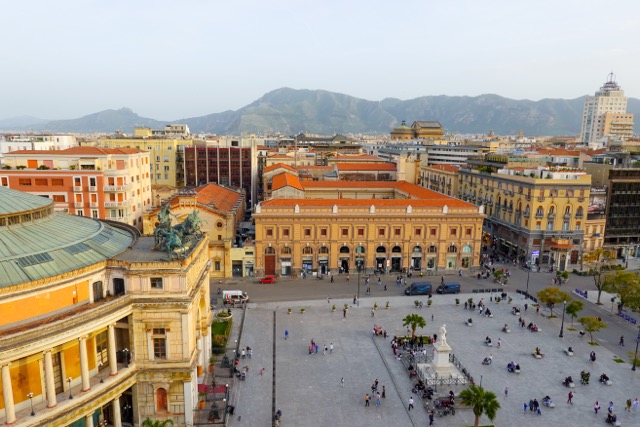


Sicily’s geography is also rich and diverse with a varied landscape including mountains, plains, a long coastline, and four archipelagos. It’s location at the meeting point of the African and Eurasian tectonic plates results in plenty of seismic and volcanic activity. In fact, Mount Etna, Europe’s largest active volcano, was erupting during our visit. More about that later.
Palermo: A City of Contrasts – Bonnie
Palermo, Sicily’s capital, is a city of contrasts where faded grandeur and urban decay exist alongside stunning historical treasures. Many once opulent palazzi (palaces) are in various states of disrepair due to decades of economic struggle, political corruption, and organized crime. The streets, chaotic and gritty, are filled with rickety Vespas and e-scooters, hanging laundry, abandoned buildings, neglected sidewalks, and graffiti covered crumbling walls. As we walked the streets during the four days we spent in Palermo, I was struck by a deep sense of resilience and authenticity. It took a minute, but once I was able to embrace its imperfections, Palermo became captivating.
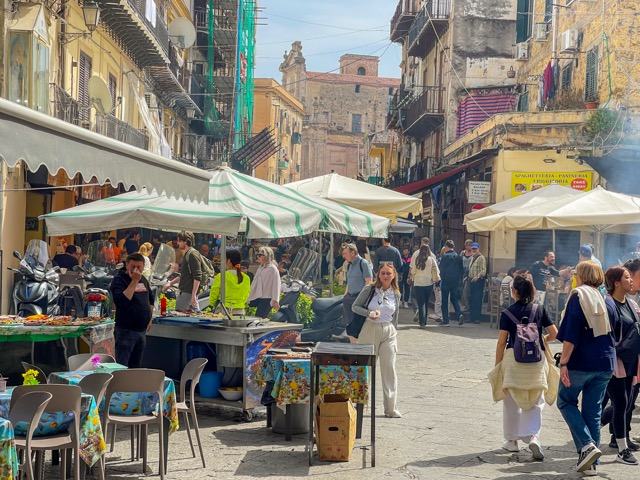
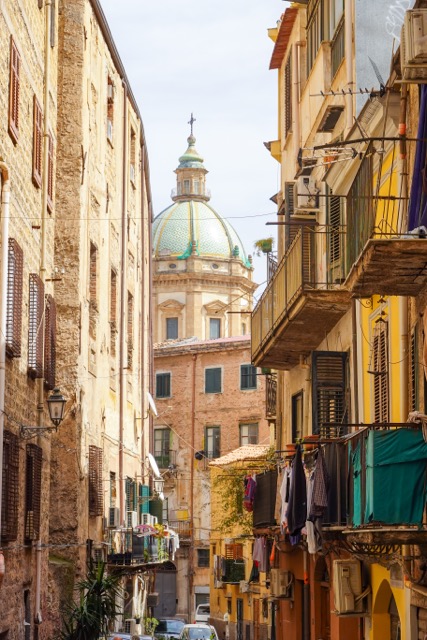
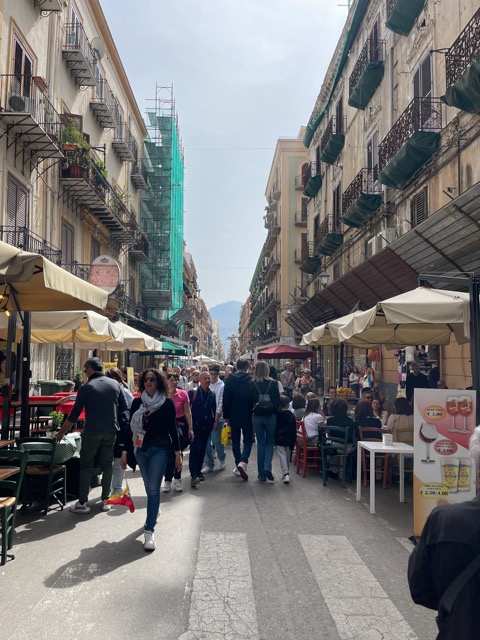
There are several UNESCO World Heritage sites in the city of Palermo – two palaces, three churches, a cathedral, and a bridge – that are architectural treasures. Dating back to 1185, Palermo’s Cathedral, with a unique blend of Western, Islamic and Byzantine architectural styles, is a stunning example of the city’s long history of diversity and multiculturalism – an inscription from the Quran can still be seen on on of the portico’s columns. And, the cathedral was built in a sacred area, where the Phoenicians, Byzantines and Arabs had previously built their own places of worship.
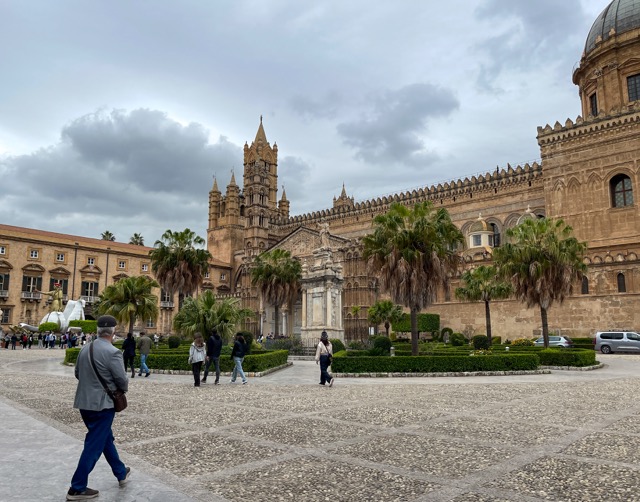
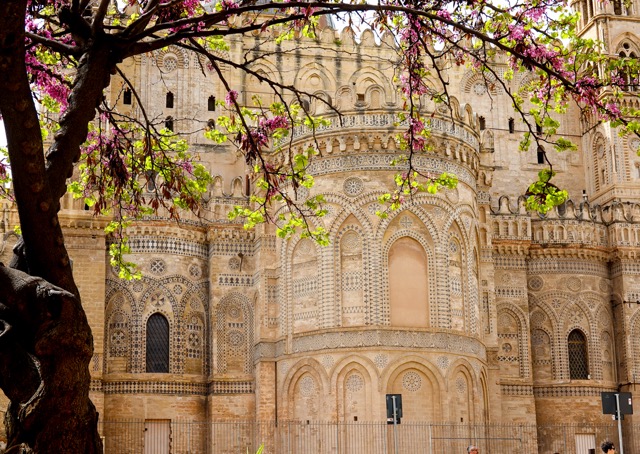
Full of life, activity, and architectural treasures, we enjoyed walking around and exploring this historic city.
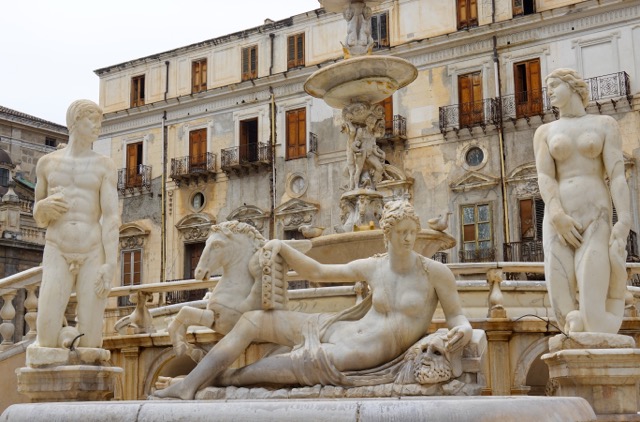

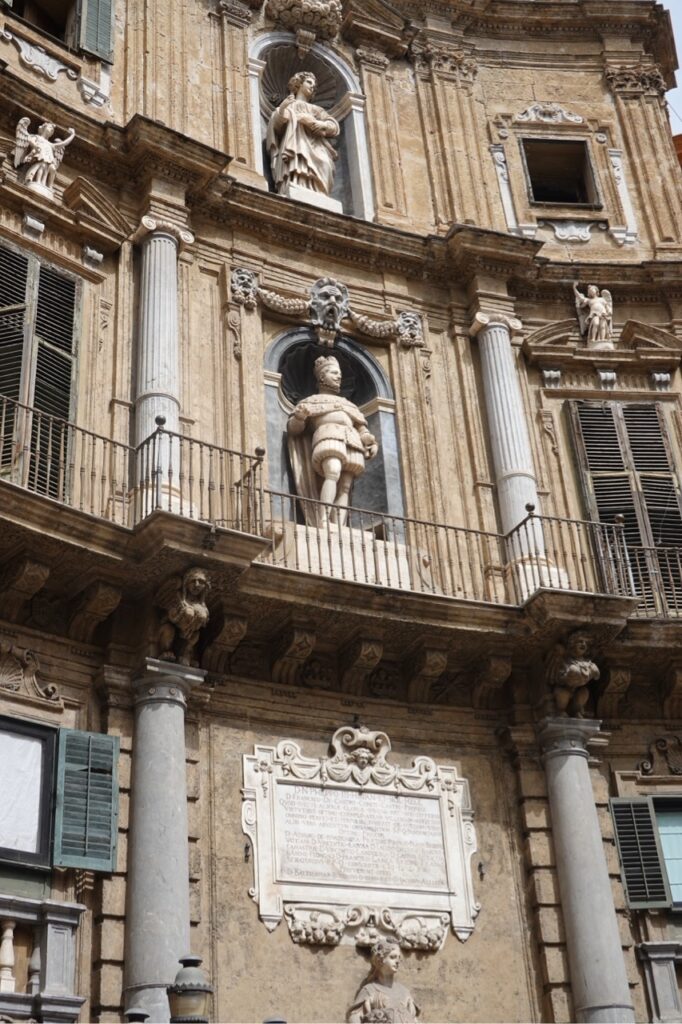
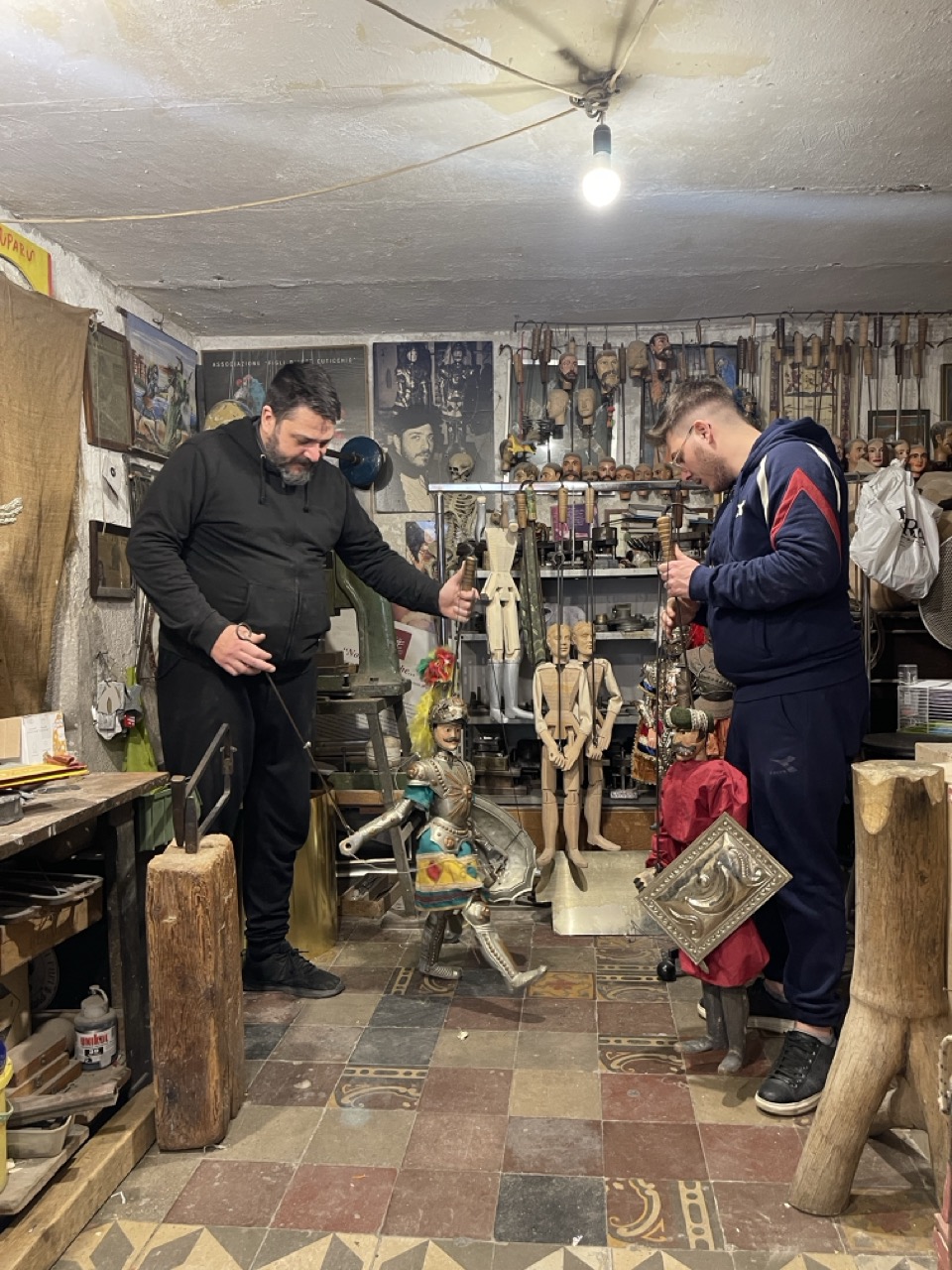
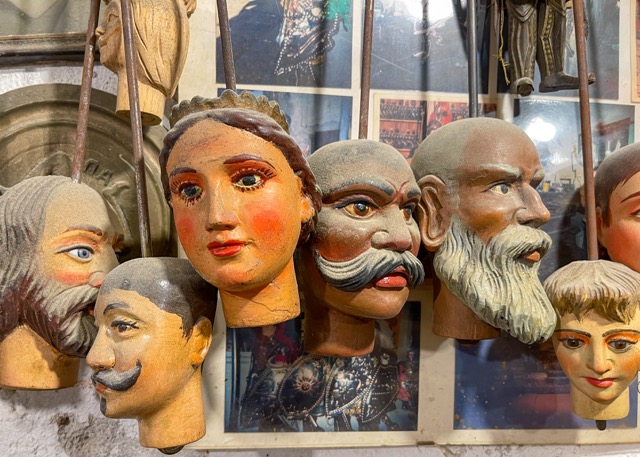
The Opera – Ed
Last year we’d enjoyed a wonderful evening in Naples at a performance of Norma in the Teatro de San Carlo, which has been presenting opera longer than any other venue in the world. So, when we heard about Faust being presented in Palermo at the Teatro Massimo, we were all primed. This is one of Sicily’s Crown Jewels – the largest opera house in Italy and third largest in Europe.
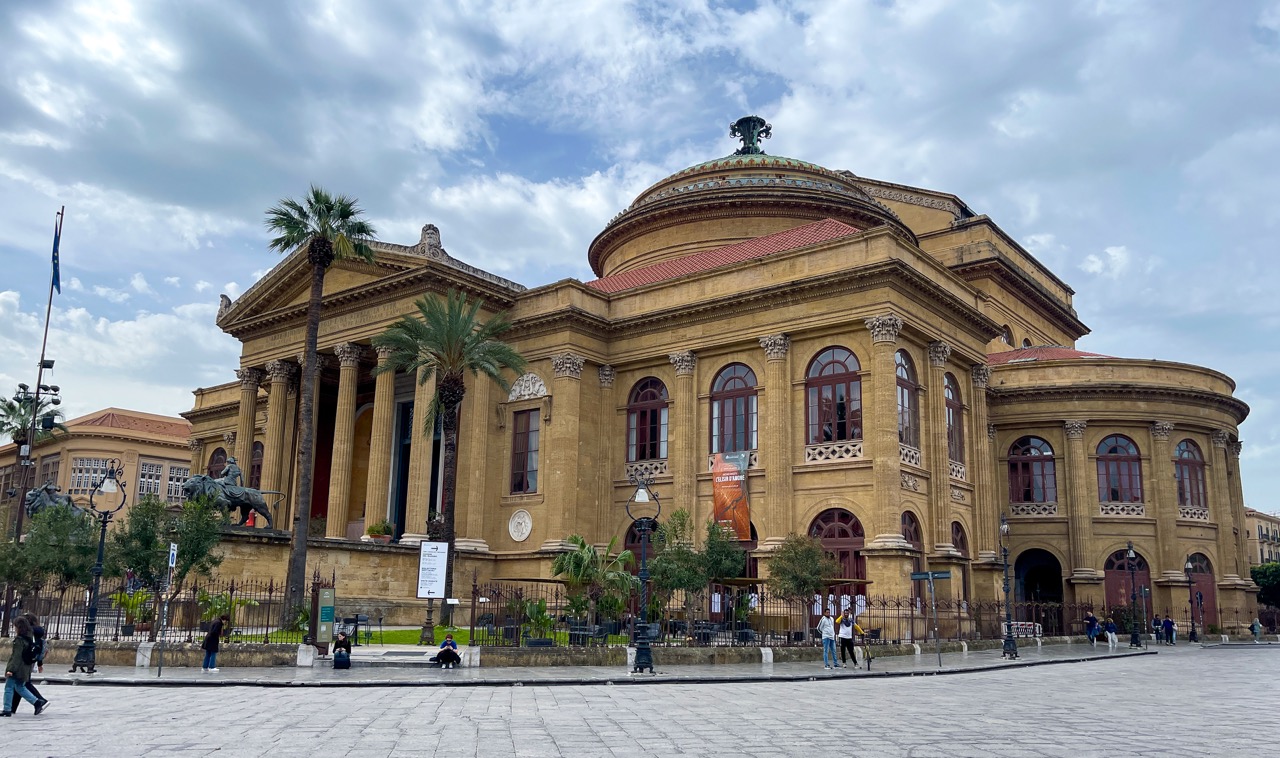
Faust, as you may remember, is an ancient legend about a guy who sold his soul to the devil in exchange for a few sordid pleasures here on earth. The opera was written by the French composer Charles Gounod, but his inspiration was from a much earlier work of art. The original two-part epic poem by Johann Wolfgang von Goethe is considered one of the greatest works of literature ever penned. Gounod and a couple of librettists – Jules Barbier and Michel Carré – turned the Goethe’s version of the story into a celebrated opera. Years late, another writer – this time a Russian, named Mikhail Bulgakov, wrote a novel reinterpreting Goethe called The Master and Margarita which he set in 1930’s Moscow. Bulgakov’s novel is hailed as one of the masterpieces of the 20th century. All that to explain that for the production we were privileged to experience in Palermo, the director, Fabio Ceresa, conflates Bulgakov’s vision of 1930’s Moscow with Gounod’s opera to stage a fascinating and thrilling rereading of a classic opera. It was a lot.
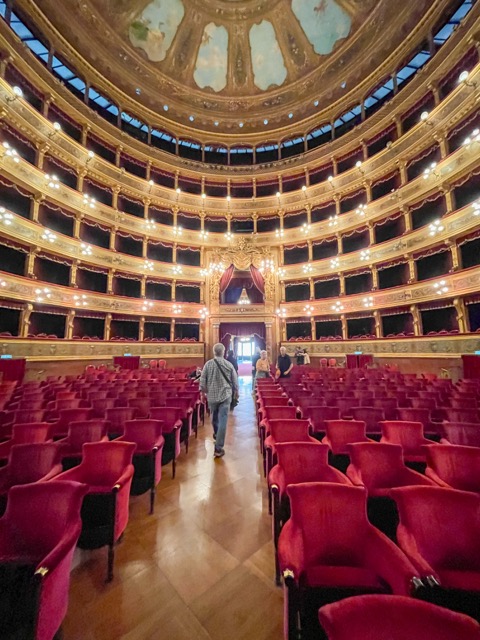
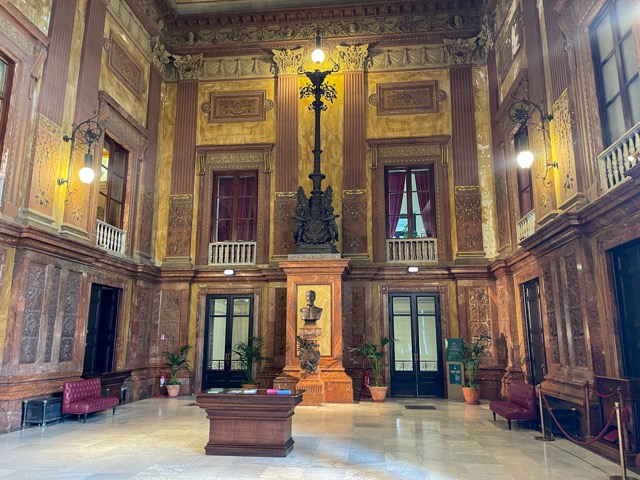
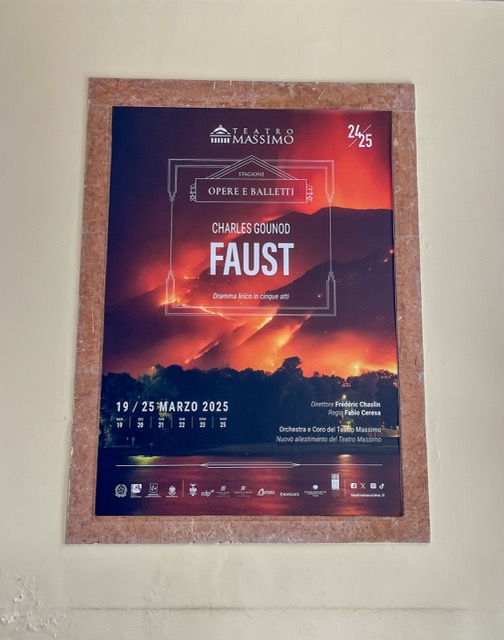
Here, l would like to pause for a rather personal aside. Our 50th wedding anniversary spurred a bit of reflection on what exactly accounts for this bond, that has held through the decades. We’ve come to realize that high on the list is a shared, unquenchable thirst for learning. Our experience at the Teatro Massimo is a typical example. We have spent over a week, now, reading and sharing our thoughts on Goethe, Gounod, the importance of baritones, Bulgakov’s novel, and Ceresa’s surreal staging. We are exposing our ignorance and sharing the excitement of discovery. We have late night discussions on the meaning of life and how all of us navigate through its perils. I am so blessed to have such a life partner.
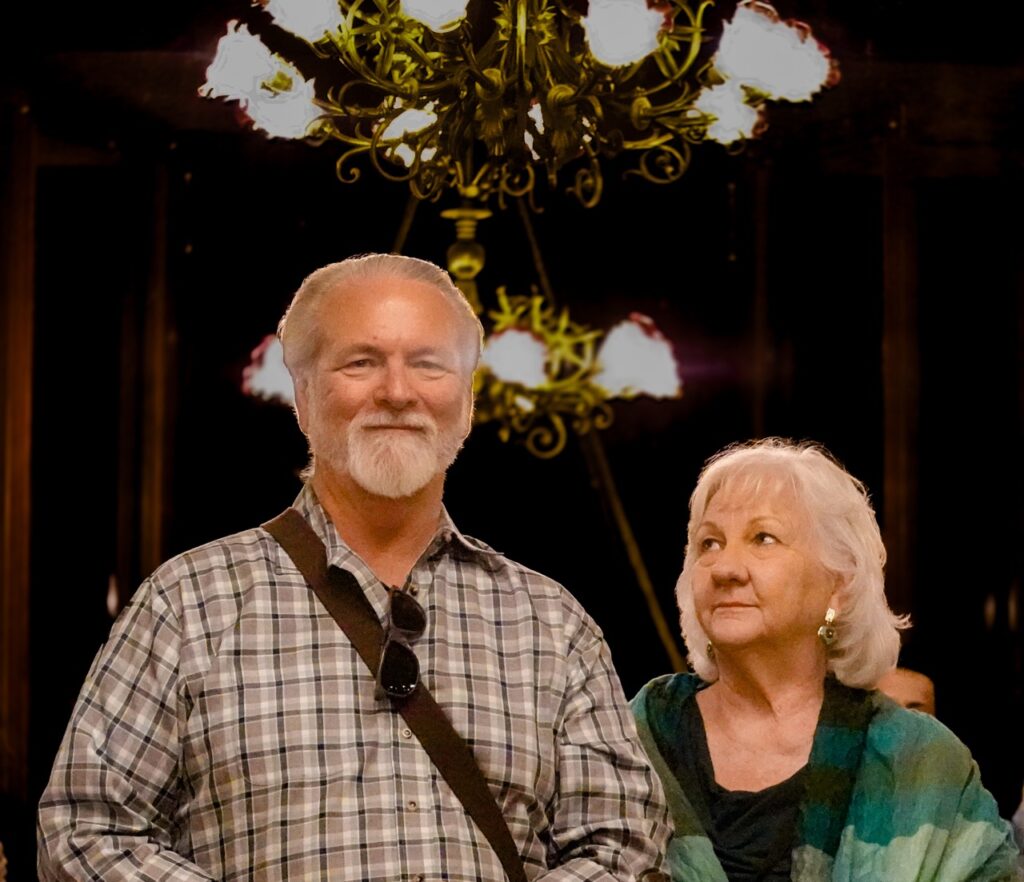
That night, as we headed into the warren of the city in search of a post-performance bite, one of our companions exclaimed “that was just nuts!” Just so. The production was a mashup of iconography, mysticism, social commentary, color, light, sound, and unhinged imagery. I was thrilled. And challenged. And mystified. The acoustics in this grand opera house were the equal of any I have ever heard. The performances were exceptional – subtle, nuanced and restrained early, allowing the drama to build to a memorable crescendo involving an immense chorus in full- throated celebration.
Haunted as I have been ever since, I am working on an essay to critique what I have come to believe is an important connection between elements of Ceresa’s production of Faust and the culture of Sicily. Stay tuned but be warned: it’s going to get nerdy.
Cosa Nostra – Bonnie
Just four weeks before we left for this trip, I saw a news article about the arrest of 183 mafia members in Palermo. Hmm . . . something to think about? I forwarded the article to Sheila, told Ed about it, and put some effort into not worrying. While Sicily has been practically synonymous with organized crime for decades, we learned that Cosa Nostra is a shadow of what it was in the 1980’s, a period of horrific violence. It is, however, still alive and well. The investigation leading to the recent arrests revealed that while some Cosa Nostra still yearn for the infamous crimes of the past, the new generation are more discrete, keep a lower profile, and are adapting to modern realities. They are using encrypted mobile phones and short life micro-sim cards smuggled into prisons to prevent being eavesdropped while they focus their efforts on drug crime, money laundering, online gambling, and infiltrating legitimate businesses.
“They just don’t make mobsters like they used to.”
Mafia boss, on a police wiretap, bemoaning the difficulty of finding good staff nowadays.
In addition to the intensive work by law enforcement, public resistance has grown significantly. We spent three hours on a walking tour with Addiopizzo, a non-profit, grass-roots organization based in Palermo. Addio translates to “Goodbye” and “Pizzo” is the monthly “protection” money businesses are strong armed into paying. As a result of Addiopizzo’s efforts, there are currently about 1200 businesses in Palermo that have committed to saying “NO” to the Mafia. These businesses display a sticker on their doors to let mafia members know they are not welcome and to communicate their commitment to consumers.
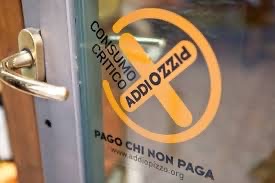
Addiopizza also encourages the public to support these businesses through various educational campaigns. Of course, 1200 is a very small percentage of Palermo’s businesses, but it’s a start. As the Addiopizza tour continued, it dawned on me that a similar consumer-activist approach is beginning to take root as a form of resistance to the tactics being employed by the regime in the U.S.
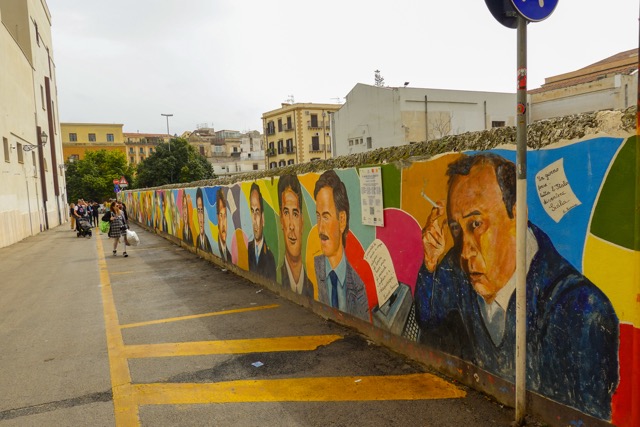
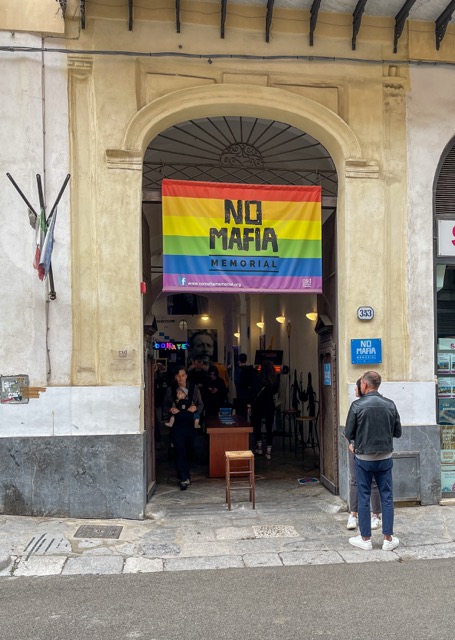
The Il Muro della Legalità (Wall of Legality) in Palermo’s central district, just behind the Teatro Massimo, is a poignant testament to those who have contributed to the fight against organized crime in Palermo. The vibrant images reflect the struggles and the resilience of the local community and their commitment to justice. As we walked along this wall of murals, I was overcome by feelings of grief for those lost, admiration for their sacrifice, and hope for a Palermo that refuses to be defined by its past.
Our guide told the story of each individual’s role and contribution. Of course, the now famous anti-mafia prosecutors, Giovanni Falcone and Paola Borsellino, who were murdered by the Sicilian mafia in 1992, are a highlight of this unique blend of art, history, and activism.
I was especially drawn to the women portrayed in this powerful mural. In particular, I found the story of Letizia Battaglia to be inspiring and powerful. Letizia was a photographer whose images, depicting the victims of Mafia violence, were a form of condemnation and activism. A documentary film of her life, ‘Shooting the Mafia” was released in 2019 and can be streamed on Prime TV or Apple Video (in Italian with English subtitles). I have a collection of images of important, inspirational, and powerful women that I have been assembling from our travels. Letizia will be the latest addition to my wall of heroines.
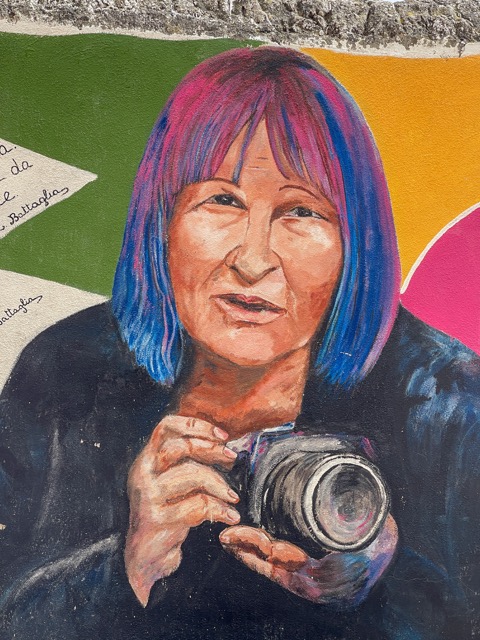
Migrants – Bonnie
Sicily has been a major landing point for people fleeing war, poverty and oppression through Africa and the Middle East. We’ve all read the stories and seen the images of over-crowded boats crossing the Mediterranean full of people desperate for a safe place to live. Many communities throughout Sicily, despite significant economic struggles of their own, welcome, feed, provide clothing and temporary shelter.
“We find bodies in our nets.”
Pietro Riso, Sicilian Fisherman
In 2023, Lampedusa, Sicily’s southernmost island, was a Nobel Peace Price nominee for their efforts to rescue and assist migrants. As the the number of migrants has skyrocketed, the hardship and strain on Sicilians has intensified. The human suffering is unimaginable, and the worst of humanity is in plain view. There are also many compassionate Sicilians doing what they can to help. The projections are for an acceleration of migration. I can only hope that love, care and empathy will triumph over corruption and greed.
“We are the people of the most conquered island in the world, where one wave of invaders just changed another, and so we created and inhabited our own universe, where the past — Phoenician, Greek, Roman, Byzantine, Jewish, Arabic, Norman, French, Spanish — was never rejected but accepted and embraced.”
Bianca Del Bello, Palermian Tour Guide
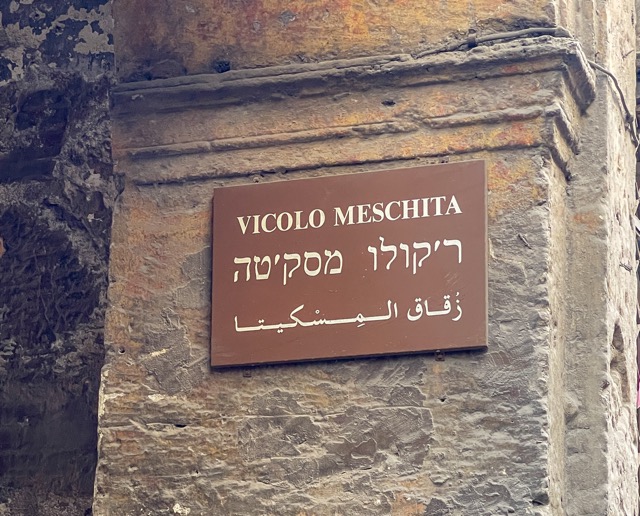
The Food – Ed
To anyone reading our blog posts regularly it must seem that we are obsessed with food. Maybe. But I think it’s actually a bit more complex. Among the reasons we love travel is to experience the vast array of traditions and cultural practices humans have evolved through the ages. Exploring the food in any given region is a window into that culture. This seems particularly true in Sicily where the food has been influenced by one civilization after another as successive empires have waded across the island. And we’re obsessed with food.
Dating back to the Muslim era (831-1072 CE), Mercato del Capo is Palermo’s most authentic market with colorful stalls selling fresh produce, fish, meat, spices, nuts, olives, wine, bread, cheese and many other local goods. Like many large urban markets, the vivid colors, enticing aromas, and boisterous sounds of vendors are a feast for the senses. There is also a staggering array of street food and dining experiences to enjoy.
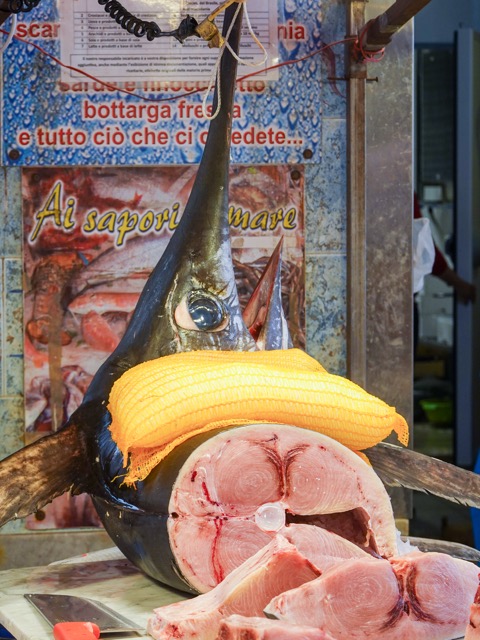
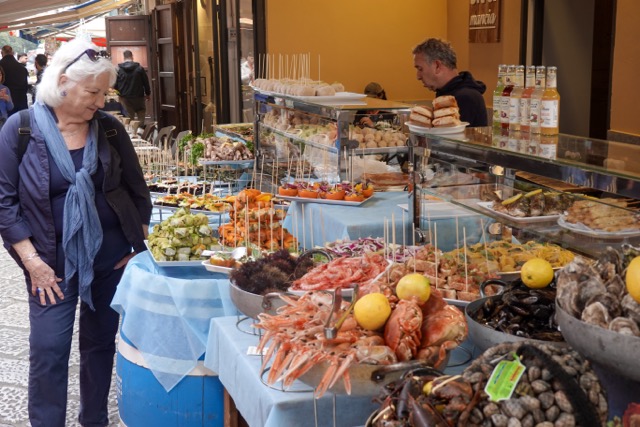
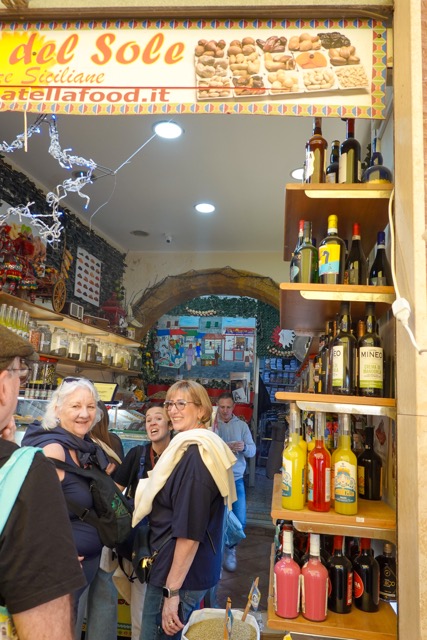
Italian food is generally beloved by Americans like us, so the markets and restaurants of Palermo produced few actual surprises. That said, it never fails to bring joy when we are privileged to sample the original of a dish that is widely imitated. Let’s start with a humble street food, ubiquitous in Sicily: arancini. First, the humble part. Sicily is a poor region of Italy. This has been true throughout history. The legacy of poverty is ageless and can be attributed to geography, politics, and organized crime. So, the people of Sicily have long had to find ways to do more with less. For a vast percentage of the earth’s poor, rice is sustenance. So, how do you turn this humble ingredient into a flavor bomb? Stepping out of the chaos of Palermo’s Capo Street market into the domain of a slight woman who is a local master of arancini, we received a lesson. The rice used is a large, stubby variety that is first prepared risotto style, glazing each grain with a starchy mortar mixed with a hint of saffron for color and fragrance, and a dollop of butter for that rich mouthfeel. After resting overnight to achieve the perfect texture, the rice is scooped into the palm and a spoonful of filling added. Here the key is bold flavor – salty cheese, sun-dried tomato, diced sausage, meaty ragu – or any of a host of options to achieve as much flavor as possible from a very modest portion. Now the rice is shaped into a lovely oblong the size of a duck egg and coated with another humble element: breadcrumbs. The final assembly is dropped briefly into hot oil.
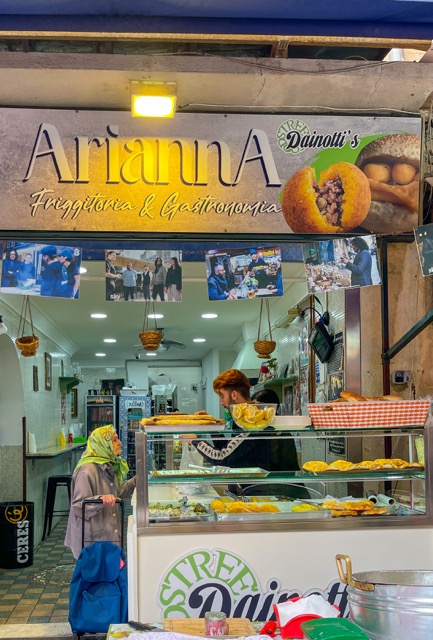
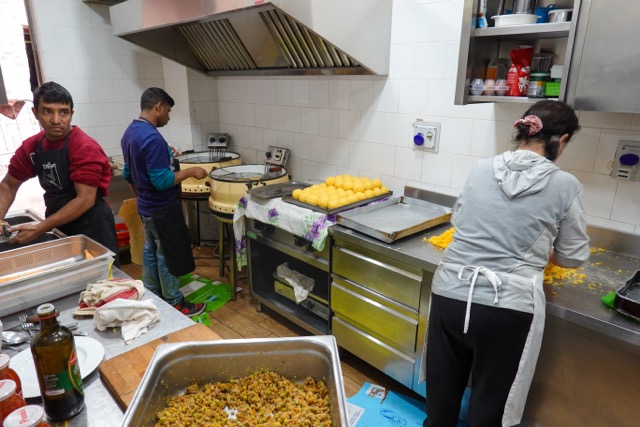
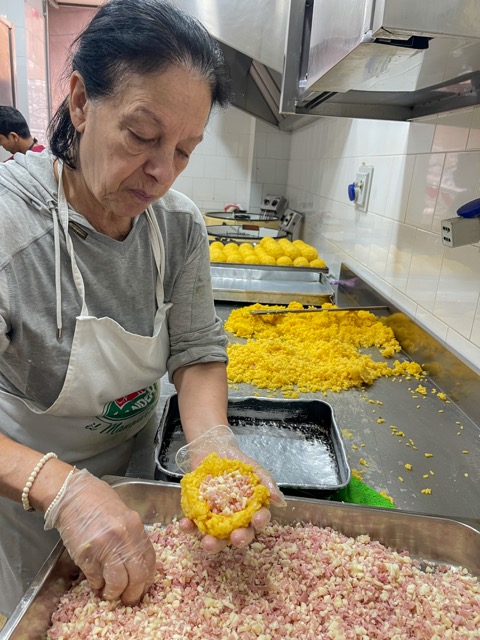
Yes, I’ve had fried rice balls before, sometimes labeled arancini and sometimes not. But this was something else. A wonderfully crisp, tender crust enclosing a soft creamy mantle with a core of intense flavor. This experience was repeated with anchovy panzerotti (turnovers), ravazzata (stuffed brioche), pizzetta (tiny pizza), and spitino con la carne (bread stuffed with ragú). Each one a simple street food, executed by cooks who have mastered every detail to create a nearly perfect meal from the humblest of ingredients.
In the trattorias and osterias we frequented, another staple of Sicily was always on the menu – Pasta alla Norma. Beloved throughout the island, it has a much more recent history, created, as the story goes, to celebrate the opera created by Vincenzo Bellini, one of Sicily’s favorite sons. Here again, you have the simplest ingredient list: tomato, basil, and eggplant, topped with shavings of ricotta salata. Its vibrant flavor depends on the quality of the ingredients and the execution, both plentiful in this culinary landscape. We ate it four different times in eight days – each one better than the last.
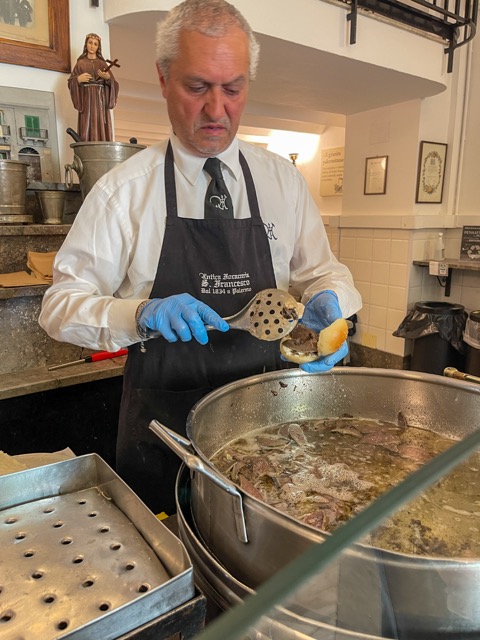
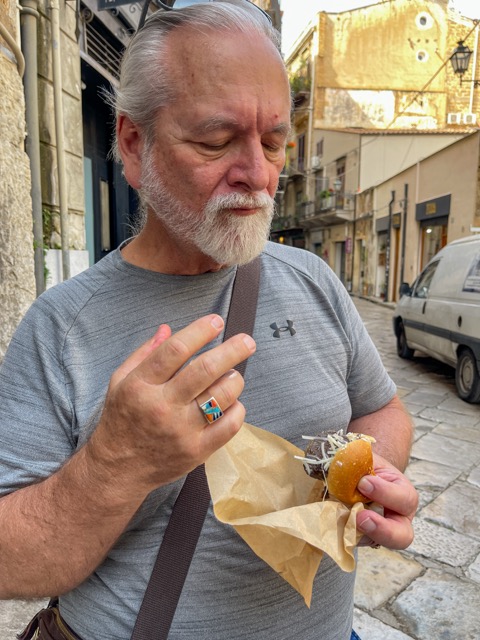
Bonnie insists that I include a word about another street food that is particular to Palermo. Since I was the only one of our little group to actually eat a Pani ca’ Meusa (spleen sandwich), I do feel an obligation to report on the experience. Once again, the Sicilians found a way to utilize the discards of the elite for a savory, filling taste treat. We’re talking street food delicacy here! Cow spleen, lung, and trachea are first boiled, then thinly shaved, then fried in lard, before being piled into a freshly baked roll. I had mine maritata style – that is sprinkled with shredded cheese. I was expecting it to be an acquired taste kind of moment, but it was actually quite good – mild livery flavor with a pleasant, soft chewiness.
Taormina – Bonnie
After a four-hour ride, our train from Palermo deposited us in the post-card perfect seaside resort town of Taormina on the east coast of Sicily. Perched on a hill with stunning views of the Ionian Sea on one side and Mount Etna on the other, Taormina was the perfect respite from bustling Palermo.
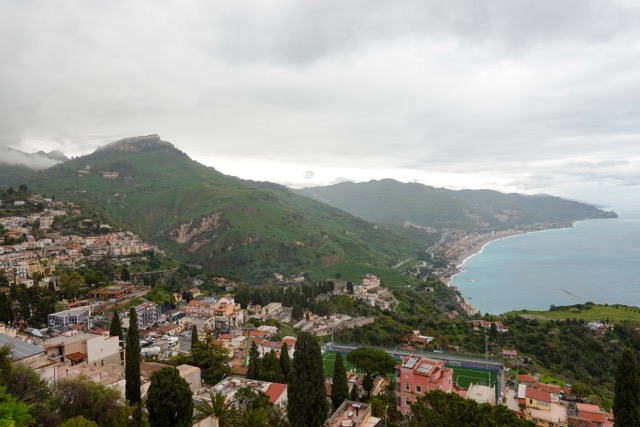
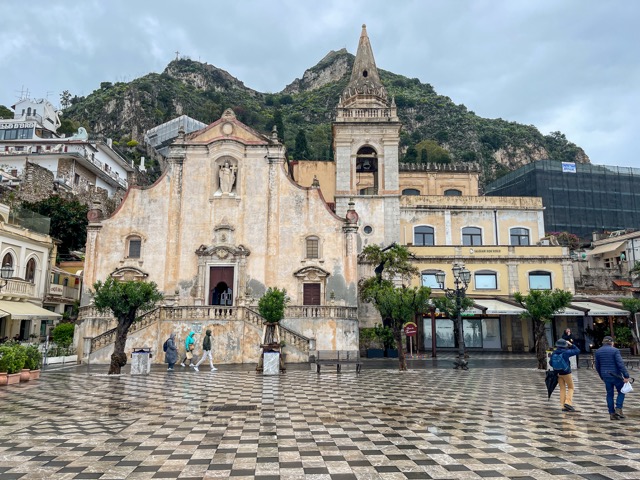
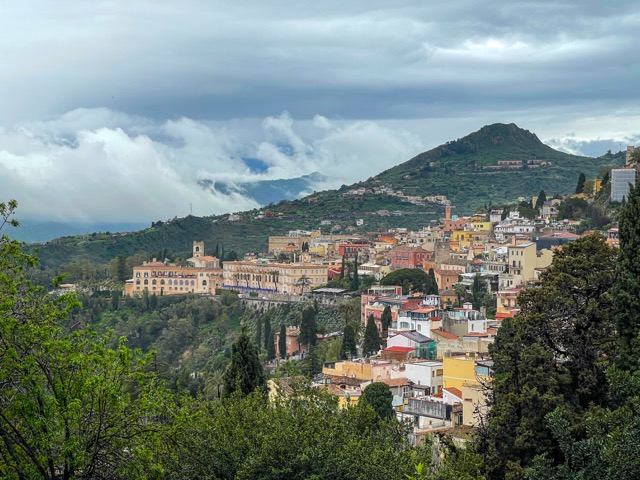
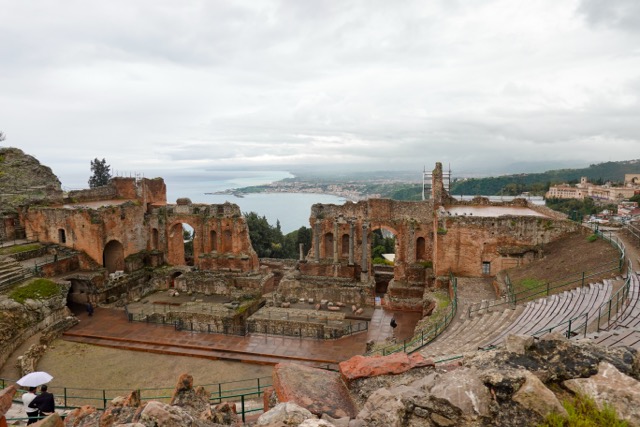
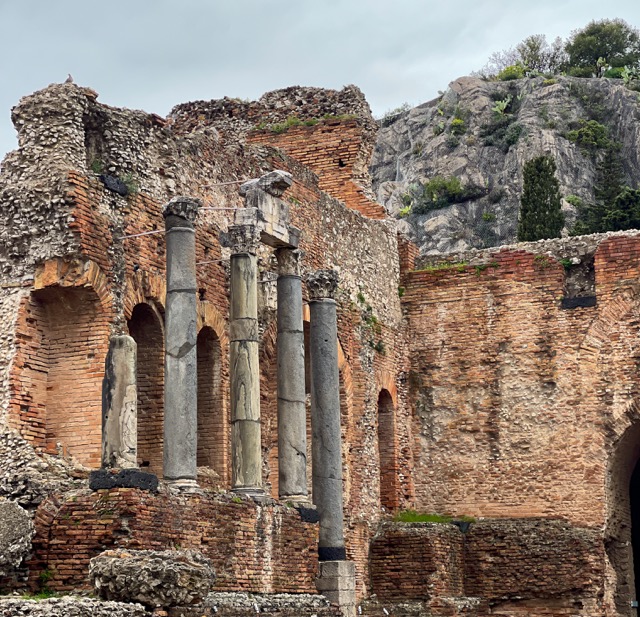
Our two days in Taormina included a trip up the slopes of Mt. Etna, an active volcano known for its frequent eruptions (including during our visit!). Imagine lava flowing down snow covered slopes. We didn’t get close enough to the crater to see this amazing display of fire and ice, but we did enjoy exploring the diverse landscape around Mt. Etna. A short hike into the lava fields of past eruptions was striking, especially with the white birch trees growing in the black lava rock. Our hike was interrupted by a bit of icy/snow type stuff falling from the sky. As we wound our way back down the slopes, the richness of the volcanic soil was evident in the many vineyards, citrus groves, chestnut forests, and almond, hazelnut and pistachio orchards. We ended our day with a tasting and lunch at a lovely family-owned winery. Magical.
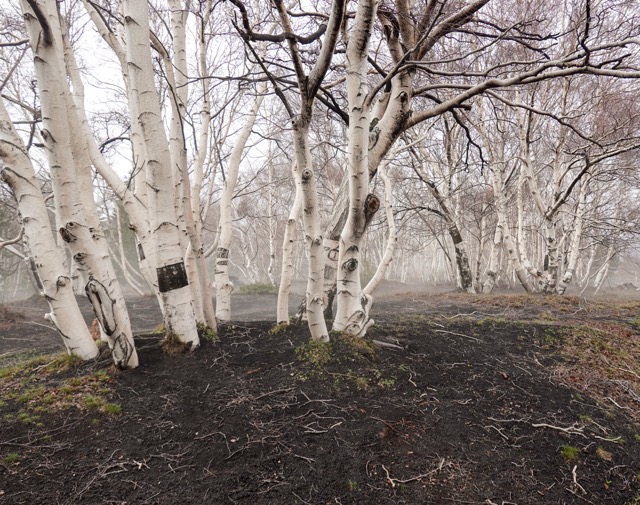
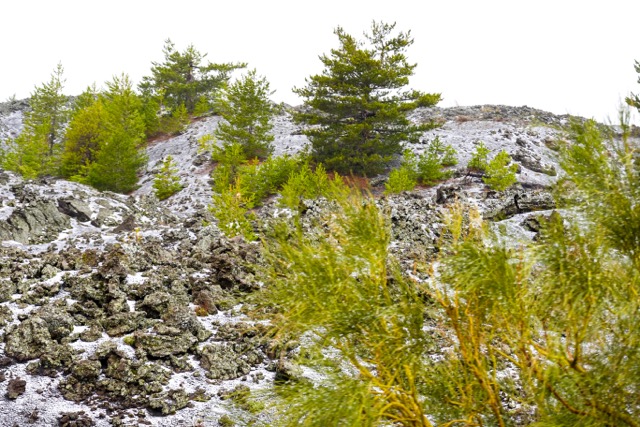
Catania – Ed
An hour south on a local train and the respite Taormina provided was over. We found ourselves back in the midst of a vibrant, chaotic, old city. Sitting at the base of Mt. Etna, Catania is referred to as the “Black City” because of the use of lava rock as a primary building material and the volcanic soot on its buildings. It turns out that Catania has been destroyed and rebuilt at least seven times due to volcanic eruptions and earthquakes. Talk about resilience.
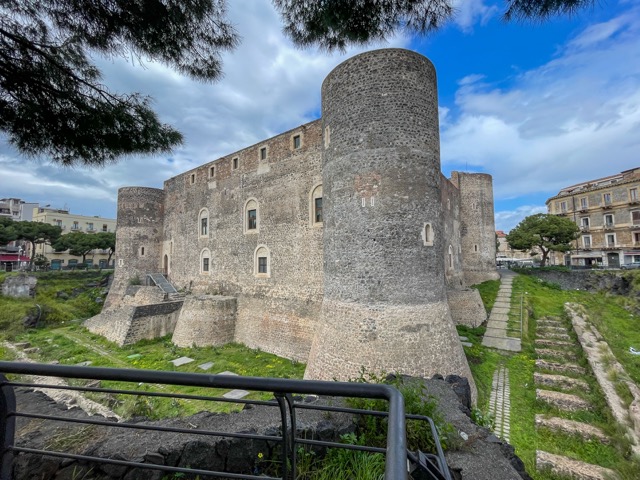
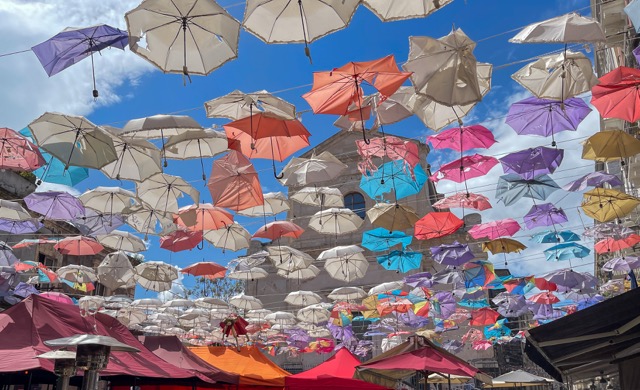
Here, we were fortunate to find ourselves enjoying a cooking lesson with a native of Catania, Chef Riccardo Messina. Riccardo had left Sicily four decades ago to travel and cook in various parts of the world before settling in Shanghai, China where he opened his own restaurant. A couple of years into that venture, Michelin awarded him two stars and he became a rock star on the Asian food scene. Like many of us, the Covid epidemic forced him to rethink his future, and he returned to Sicily, retired from the restaurant business, and decided that meeting and cooking with new people every day was not a bad retirement. Chef Riccardo left it to us to create the menu, and I wanted to focus on the abundant quality seafood on the island.

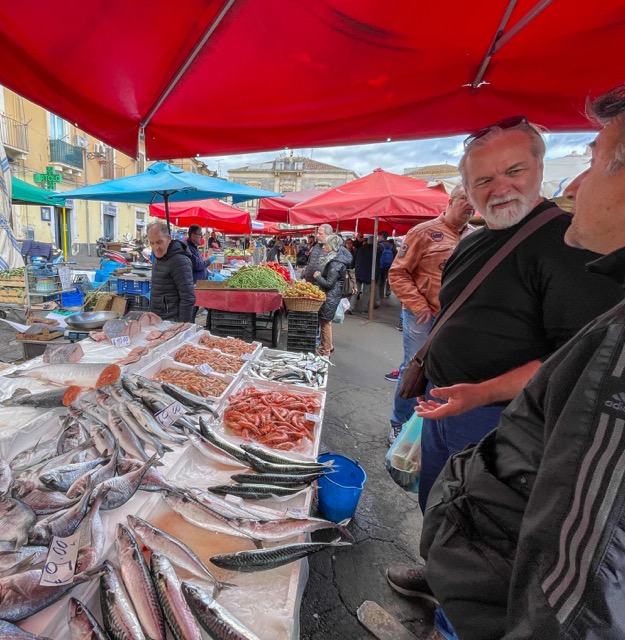
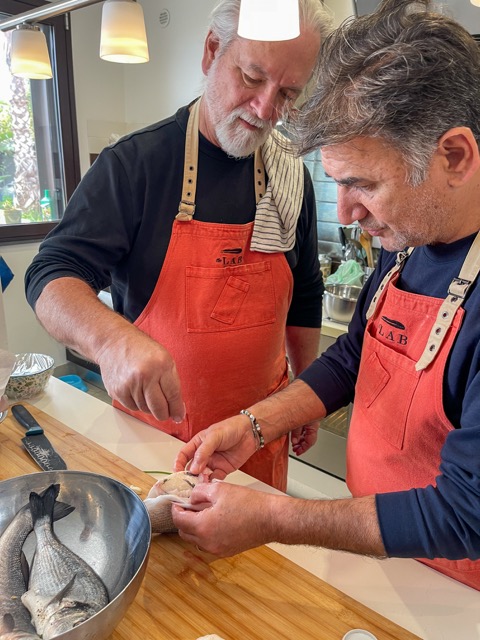
We wandered through Catania’s street market, stopping to inspect the offerings from various fish mongers. In the end, we purchased sea bass, sea bream, mussels, calamari, and red prawns. Chef Riccardo got a little carried away with the produce – artichokes, eggplant, squash, tomatoes, and an assortment of pickles and olives. On the way to his home, we stopped in a little side street to purchase wine and bread. What ensued was a quirky and delightful afternoon, like going to a friend’s house to cook and drink wine together. Our menu evolved as we worked and was filled with small insights and appreciation for the simple use of great ingredients. Riccardo’s wife, Sally, was a delight and we left feeling we had truly experienced Sicily.
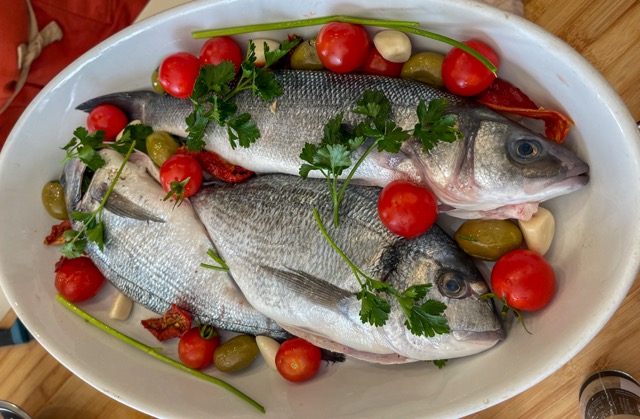

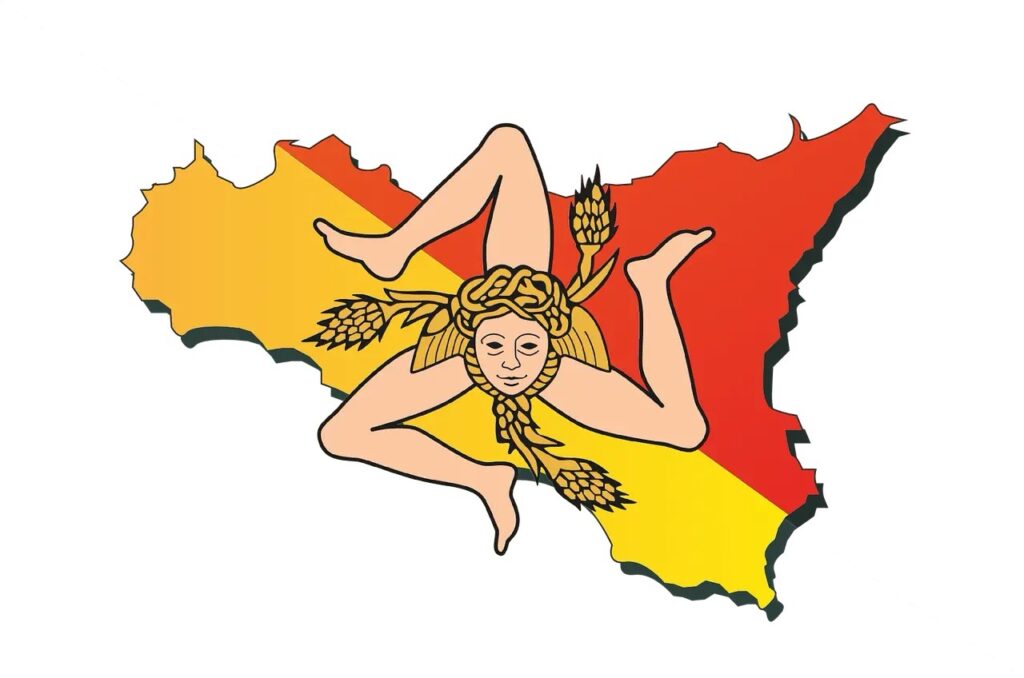
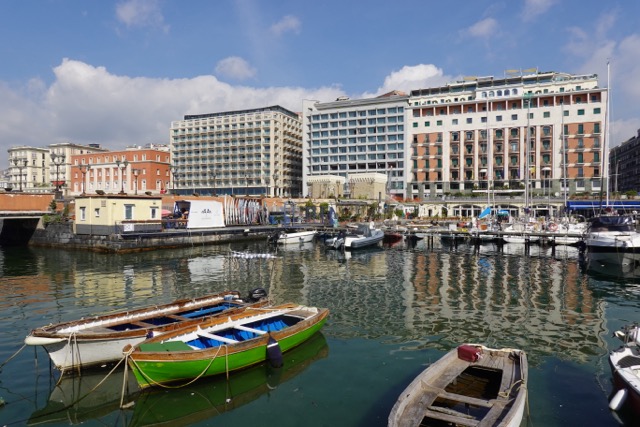
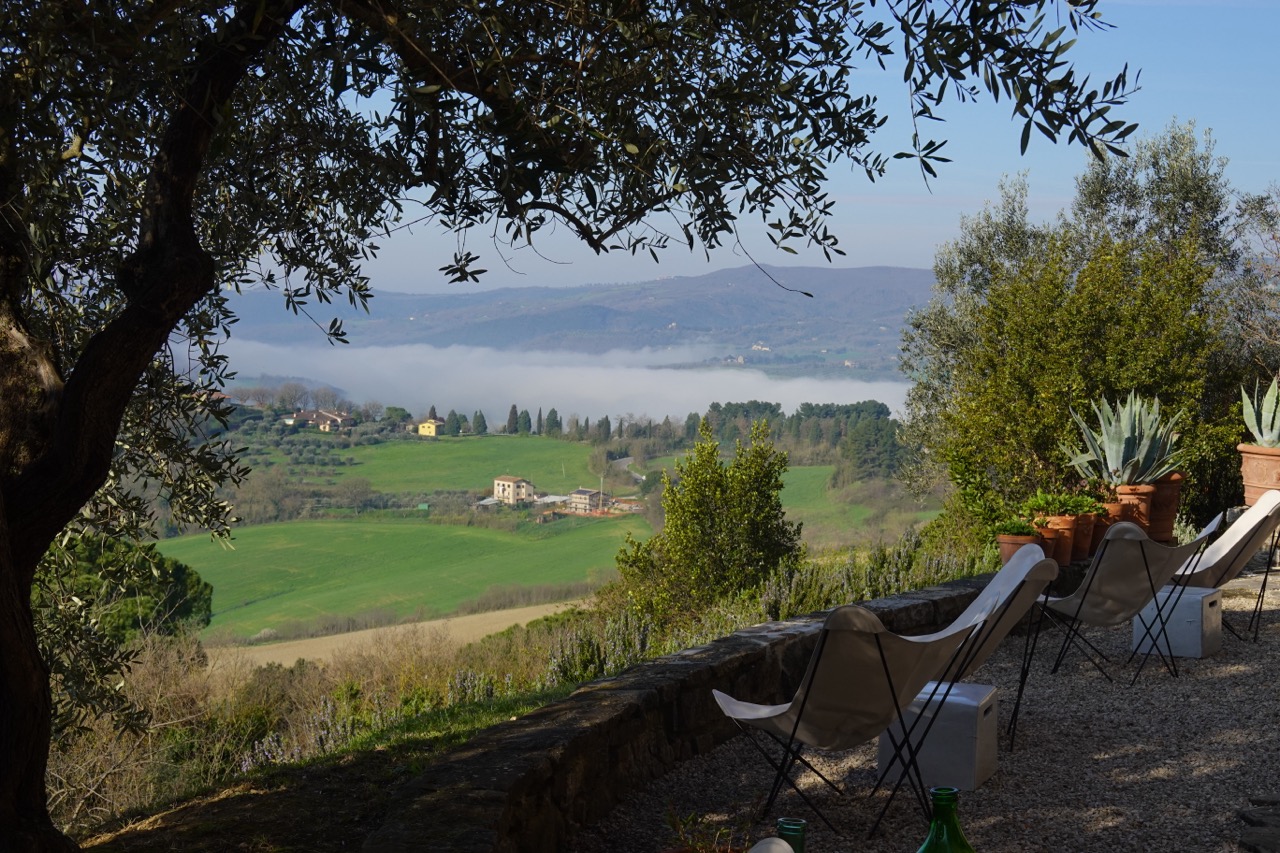
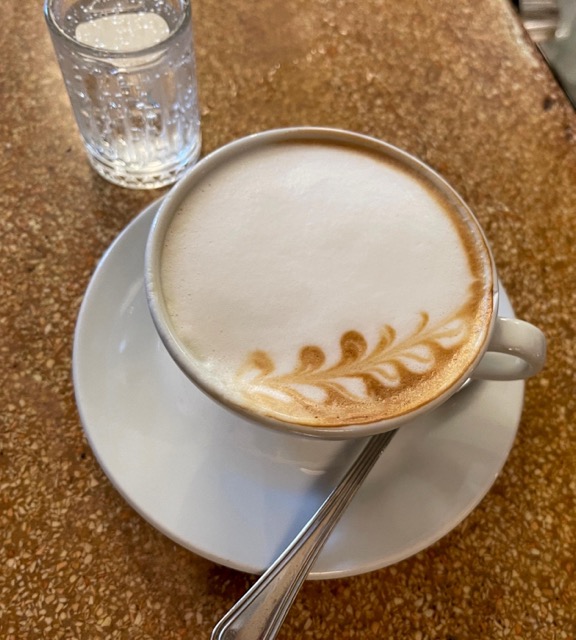
This was a REVELATION! Have always wanted to visit Sicily and now I feel that I have through your collective eyes, ears, and mouths! You capture the Crazy History and Fascination of Palermo and the serene beauty of Taormina as I can only. imagine it. And there’e definitely More to explore on a return visit. Talk about a great Escapes–you two are mastering the art of it!
Meanwhile we are witnessing Protects, small, large, and Huge, throughout All Fifty States Rachel Maddow (MSNBC) is doing a Masterful job of capturing the Energy as it grows Exponentially each day.! The Center Cannot Hold. We had our own Tesla Protest here in LG and I spoke to Town Council as a part of a larger showing. The 15 and 16 year olds were Especially potent.
The Beat Goes On! Jo G. xo